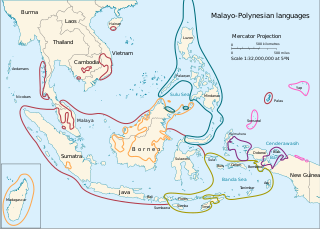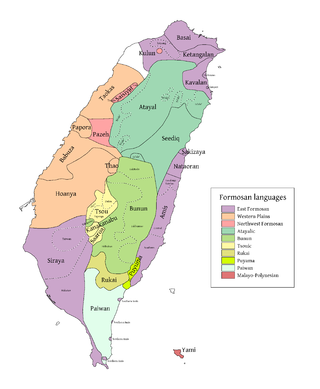
The Austronesian languages are a language family widely spoken throughout Maritime Southeast Asia, parts of Mainland Southeast Asia, Madagascar, the islands of the Pacific Ocean and Taiwan. They are spoken by about 386 million people. This makes it the fifth-largest language family by number of speakers. Major Austronesian languages include Malay, Javanese, Sundanese, Tagalog (Filipino), Malagasy and Cebuano. According to some estimates, the family contains 1,257 languages, which is the second most of any language family.

The Malayo-Polynesian languages are a subgroup of the Austronesian languages, with approximately 385.5 million speakers. The Malayo-Polynesian languages are spoken by the Austronesian peoples outside of Taiwan, in the island nations of Southeast Asia and the Pacific Ocean, with a smaller number in continental Asia in the areas near the Malay Peninsula, with Cambodia, Vietnam and the Chinese island Hainan as the northwest geographic outlier. Malagasy, spoken in the island of Madagascar off the eastern coast of Africa in the Indian Ocean, is the furthest western outlier.

The Philippine languages or Philippinic are a proposed group by R. David Paul Zorc (1986) and Robert Blust that include all the languages of the Philippines and northern Sulawesi, Indonesia—except Sama–Bajaw and a few languages of Palawan—and form a subfamily of Austronesian languages. Although the Philippines is near the center of Austronesian expansion from Formosa, there is little linguistic diversity among the approximately 150 Philippine languages, suggesting that earlier diversity has been erased by the spread of the ancestor of the modern Philippine languages.

Pazeh and Kaxabu are dialects of an extinct language of the Pazeh and Kaxabu, neighboring Taiwanese indigenous peoples. The language was Formosan, of the Austronesian language family. The last remaining native speaker of the Pazeh dialect died in 2010.

The Malayic languages are a branch of the Malayo-Polynesian subgroup of the Austronesian language family. The most prominent member is Malay, which is the national language of Brunei, Singapore and Malaysia, and is the basis for Indonesian, the national language of Indonesia. The Malayic branch also includes the local languages spoken by ethnic Malays, further several languages spoken by various other ethnic groups of Sumatra, Indonesia and Borneo. The most probable candidate for the urheimat of the Malayic languages is western Borneo.
Proto-Austronesian is a proto-language. It is the reconstructed ancestor of the Austronesian languages, one of the world's major language families. Proto-Austronesian is assumed to have begun to diversify c. 4000 BCE – c. 3500 BCE in Taiwan.

Robert A. Blust was an American linguist who worked in several areas, including historical linguistics, lexicography and ethnology. He was Professor of Linguistics at the University of Hawaiʻi at Mānoa. Blust specialized in the Austronesian languages and made major contributions to the field of Austronesian linguistics.

Lun Bawang or Lundayeh is the language spoken by the Lun Bawangs. It belongs to the Malayo-Polynesian family.
The Gorontalo–Mongondow languages are a group of Austronesian languages spoken in northern Sulawesi, Indonesia.
The Minahasan languages are a subgroup of the Austronesian languages spoken by the Minahasa people in northern Sulawesi, Indonesia. They belong to the Philippine subgroup.
The Greater North Borneo languages are a proposed subgroup of the Austronesian language family. The subgroup covers languages that are spoken throughout much of Borneo, as well as parts of Sumatra and Java, and Mainland Southeast Asia. The Greater North Borneo hypothesis was first proposed by Robert Blust (2010) and further elaborated by Alexander Smith. The evidence presented for this proposal are solely lexical.
The Sabahan languages are a group of Austronesian languages centered on the Bornean province of Sabah.
The North Sarawakan languages are a group of Austronesian languages spoken in the northeastern part of the province of Sarawak, Borneo, and proposed in Blust.

Kelabit is one of the most remote languages of Borneo, on the Sarawak–North Kalimantan border. It is spoken by one of the smallest ethnicities in Borneo, the Kelabit people.
Sa’ban is one of the remoter languages of Borneo, on the Sarawak–Kalimantan border. The language is known as hmeu Sa'ban in the Sa'ban language.
Belait, or Lemeting, is a Malayo-Polynesian language of Brunei and neighbouring Malaysia. It is spoken by the Belait people who mainly reside in the Bruneian Belait District. There were estimated to be 700 speakers in 1995.
Tonsawang, also known as Tombatu, is an Austronesian language of the northern tip of Sulawesi, Indonesia. It belongs to the Minahasan branch of the Philippine languages.
Tring is one of the languages of Borneo, in Sarawak, Malaysia. Ethnologue classifies the language as threatened.
The Proto-Philippine language is a reconstructed ancestral proto-language of the Philippine languages, a proposed subgroup of the Austronesian languages which includes all languages within the Philippines as well as those within the northern portions of Sulawesi in Indonesia. Proto-Philippine is not directly attested to in any written work, but linguistic reconstruction by the comparative method has found regular similarities among languages that cannot be explained by coincidence or word-borrowing.
Rejang is an Austronesian language predominantly spoken by the Rejang people in southwestern parts of Sumatra (Bengkulu), Indonesia. There are five dialects, spread from mountainous region to the coastal region of Bengkulu, including the Musi (Musai) dialect, the Lebong dialect, the Kebanagung dialect, the Rawas (Awes) dialect, and the Pesisir dialect.







